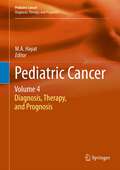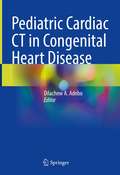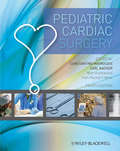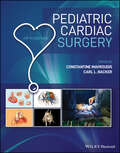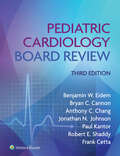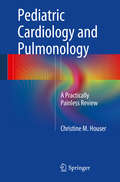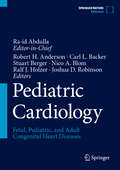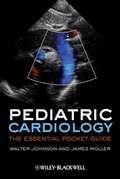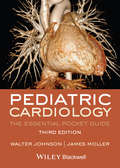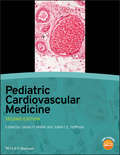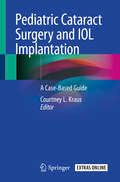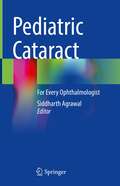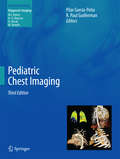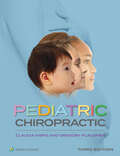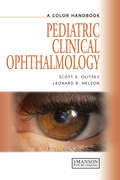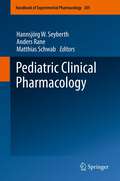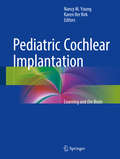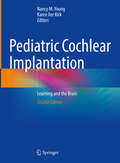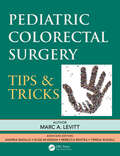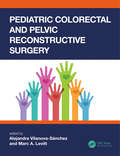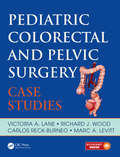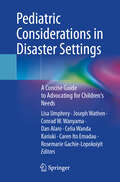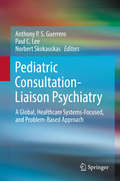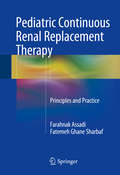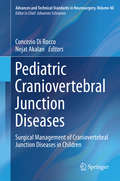- Table View
- List View
Pediatric Cancer, Volume 3
by M. A. HayatBrain tumors are the most common solid tumor of childhood as well as the leading cause of cancer-related mortality in children. This third volume of the Springer series discussing pediatric cancer focuses on diagnosing, treating, and assessing the future course of malignant brain neoplasms in children. In addition to a general introduction to the principals involved, the material includes vital research in molecular genetics, a major contribution to the molecular characterization of solid tumors, which will define new biomarkers of the disease and identify molecular pathways. Now it has become possible to achieve the goal of targeting new, more effective therapies to minimize the tragedy faced by children. This research features the application of molecular genetics in combating atypical teratoid/rhabdoid tumor (AT/RT), a highly aggressive embryonal CNS tumor that is among the most common malignant neoplasms in children, with a peak occurrence in infants younger than three years old. Contributors also examine the reasons for the common misdiagnosis of AT/RT tumors as other types of CNS tumors. They help resolve this issue by indicating the details of an abnormality in the genetics of AT/RT, which is unique to AT/RT type. The INII gene on chromosome 22q11 is involved in the AT/RT. The presence of this gene and the SMARCB1 is discussed. In addition to discussing these important topics, the volume includes presentations of present and future therapies. The volume also explains AT/RT's dissemination to the cerebral fluid, the molecular mechanisms underlying the progression of medulloblastoma, and the importance of gamma knife radiosurgery during multimodality management of medulloblastoma/PNET tumors. Other topics discussed include using magnetic resonance imaging for diagnosing retinoblastoma, and mapping the effects of radiotherapy in low-grade glioma in children. Information on alterations in cell-cycle regulators that are influenced by tumor suppressor genes and oncogenes is detailed. Contributors provide recommendations concerning non-narcotic analgesic routines for children recovering from cranial and spinal surgery. The practical knowledge of frontier-expanding research presented leads this authoritative volume to be a compelling addition to the literature.
Pediatric Cardiac CT in Congenital Heart Disease
by Dilachew A. AdeboThis book serves as a comprehensive guide to pediatric cardiac computed tomography (CT), particularly for patients with congenital heart disease. Congenital heart disease (CHD) is the leading cause of congenital abnormalities (8/1000 of live births). Over the past two decades, the diagnostic medical approach has significantly changed with a considerable increase in the number of CT studies in pediatric patients. Preoperative surgical or interventional planning for children with CHD remains crucial and challenging, but despite this and the advancement in the development of new CT techniques and radiation dose reduction methods, there are limited books addressing pediatric cardiac CT.This work fills that gap by offering a complete look at the techniques and clinical utilization for pediatric cardiac CT with liberal use of images. The text begins with overarching themes of pediatric cardiac CT, like its advantages and techniques, and moves into covering different areas of the heart and possible presentations, like atrioventricular connections and cardiac tumors. Each chapter begins with a short introduction section followed by preoperative and postoperative cardiac CT imaging, management approach, and short-term and long-term outcomes. This book also describes the novel technologies being used for three-dimensional modelling and three-dimensional printing in the surgical preparation of patients with complex congenital heart disease. This book is the first to address pediatric cardiac CT image fusion to fluoroscopy to guide cardiac catheterization in patients with complex congenital heart disease. Radiation dose reduction during cardiac catheterization is also an important part of diagnostic and interventional cardiac catheterization that is covered in detail. The book concludes with an overarching look of the role cardiac CT plays in the pre- and post-operative evaluation of congenital heart disease in children.This book is an ideal guide for pediatric radiologists, pediatric cardiologists, pediatric cardiothoracic surgeons, related trainees, and any physician interested in advanced cardiac imaging.
Pediatric Cardiac Surgery
by Carl Backer Richid F. Idriss Constantine MavroudisPediatric cardiac surgery is a dynamic, fast-moving field. Busy practitioners, like you, need clear and comprehensive guidance you can rely on to ensure optimal patient care. For over 25 years Pediatric Cardiac Surgery has been the gold-standard reference for pediatric and adult congenital heart surgeons, pediatric and congenital cardiologists, intensivists, anesthesiologists, residents and nurses. Now, in this thoroughly revised fourth edition, you again get trusted, complete coverage of the field with timely new features and expert reviews of critical topics including heart transplantation, emerging modalities for diagnosing congenital heart and tracheal defects, the surgical technique of Fontan conversion with arrhythmia surgery, the medical challenges of managing adult CHD patients, and more. This new edition includes: Contributions from over 65 world-renowned experts More beautiful illustrations, by renowned medical illustrator Rachid Idriss, which have brought acclaim to previous editions Reviews of the embryology, physical findings, diagnostic criteria, and therapeutic choices for each disease entity and describes the latest in surgical techniques in each chapter All-new chapters that guide readers through new treatment options and other key developments since the publication of the third edition highlighting recent advances in congenital heart surgery. All-new new chapters that review advances in right ventricular to pulmonary artery conduits, arrhythmia surgery, double outlet ventricles, and adult congenital heart disease, among other key topics.
Pediatric Cardiac Surgery
by Carl L. Backer Constantine MavroudisPEDIATRIC CARDIAC SURGERY Explore the leading textbook of pediatric cardiac surgery in this easy-to-read and beautifully illustrated volume The field of pediatric cardiovascular surgery includes not only heart surgery for infants and children, but also adult heart surgery to correct congenital heart defects which have been present since birth. As infant mortality from heart defects declines and patients with congenital heart defects live increasingly long and healthy lives, new challenges emerge and as such, the need for introductions to this life-saving field has never been greater. For more than thirty years, Pediatric Cardiac Surgery has met this need with an accessible, comprehensive textbook used by professionals at every level of the field. Featuring full color illustrations, this book offers an introduction to the science of cardiovascular development before moving to detailed analysis of defects in different areas of the heart and their corrective procedures. This updated fifth edition incorporates the latest science to remain the indispensable work on this subject. In Pediatric Cardiac Surgery, 5th edition readers will also find: Contributions from over 75 national and international experts in the field Stunning anatomical illustrations by Rachid Idriss New chapters reflecting cutting-edge research, as well as new material throughout pertaining to cardiac imaging and medical education Pediatric Cardiac Surgery is essential for pediatric and adult cardiac surgeons, cardiologists, and all medical professionals working with pediatric or adult cardiovascular patients.
Pediatric Cardiology Board Review
by Paul Kantor Benjamin W. Eidem Frank Cetta Bryan C. Cannon Anthony C. Chang Jonathan N. Johnson Robert E. ShadeyDesigned to effectively prepare pediatric cardiology fellows and practitioners for board certification and recertification, Pediatric Cardiology Board Review, Third Edition, provides easy access to more than 1,200 board-style questions. Based on the popular Mayo Clinic Pediatric Cardiology Review course and edited by Drs. Benjamin W. Eidem, Bryan C. Cannon, Jonathan N. Johnson, Anthony C. Chang, Frank Cetta, Robert E. Shaddy, and Paul Kantor, it covers all the latest advances in the diagnosis and management of congenital heart disease, provides full explanations for every question, and helps you make the most of your study time.
Pediatric Cardiology and Pulmonology
by Christine M. HouserOften, information in review books can raise as many questions as it answers. This interferes with the study process, because the learner must either look up additional information or skip ahead without truly comprehending what he or she has read. As an alternative, Pediatric Cardiology and Pulmonology: A Practically Painless Review presents bite-size chunks of information that can be read and processed rapidly, helping learners to stay active while studying and to pick up new information the first time they read it. This book's question and answer format allows for self-testing or study with a partner or a group. The format also facilitates dipping into the book during a few minutes of downtime at the hospital or office. Pediatric Cardiology and Pulmonology: A Practically Painless Review is a quick and easy way to master these tricky topics and is suitable for those studying for the pediatric board exam, practicing physicians brushing up their skills, and any busy clinician who wants to learn more about these topics while on the go.
Pediatric Cardiology: Fetal, Pediatric, and Adult Congenital Heart Diseases
by Ra-Id AbdullaThis reference work aims to be the primary resource in the field of heart disease in children and adult congenital heart disease. It contains nearly 100 chapters covering all aspects of heart disease in three populations: fetus with acquired and congenital heart diseases, children with acquired and congenital heart diseases, and adults with congenital heart diseases. Divided into five main sections, the book provides a comprehensive, up-to-date, and continuously revised overview of what is known in the field as well as resources for practical use such as normal values, medication information, and review of published guidelines. The first section of the book includes historical background on congenital heart disease and the evolution of medical, surgical, and catheter therapeutics. The fetal heart disease section comes next and covers cardiovascular embryogenesis, etiological mechanisms, diagnostic tools, presentation and management, cardiomyopathies, arrhythmias, perinatal management, and emergencies. The bulk of the book lies in the third section on pediatric cardiology, which examines not only basic science, assessment, and therapies but also a wide variety of specific acquired and congenital diseases such as valvular lesions, arterial diseases, cyanotic heart diseases, cardiomyopathies, cardiac tumors, and pulmonary hypertension. This is followed by the section on adult congenital heart diseases, discussing echocardiography, electrophysiology, neurodevelopment, and a variety of unique aspects of congenital heart disease in the adult years. The final section of the book focuses on pharmacology with chapters on inotropes, vasopressors, diuretics, and more. Pediatric Cardiology: Fetal and Pediatric Heart Diseases & Adult Congenital Heart Diseases is an essential reference for physicians, residents, fellows, medical students, nurse-practitioners, and allied health professionals in cardiology, pediatrics, cardiac surgery, and imaging/radiology.
Pediatric Cardiology: The Essential Pocket Guide (Core Handbook Series In Pediatrics)
by James H. Moller Walter H. JohnsonA unique and straightforward explanation of complex pathophysiology of cardiac malformations Addresses the important and growing concern of diagnosing heart disease and cardiac problems in pediatric care Provides the skills necessary for today's managed care environment in using the history, physical examination, ECG, and chest X-ray to uncover possible problems and eliminate areas of false concern Topics covered include preventive cardiology and health promotion, heart disease in the neonate and in special populations, congenital cardiac malformation, acquired cardiac conditions, and congestive heart failure
Pediatric Cardiology: The Essential Pocket Guide (Core Handbook Series In Pediatrics)
by James H. Moller Walter H. JohnsonCaring for children with heart disease is extremely complex, requiring a different and often tailor-made approach compared with adults with similar cardiac problems. Built on the success of previous editions and brought to you by a stellar author team, Pediatric Cardiology: The Essential Pocket Guide provides a unique, concise and extremely practical overview of heart disease in children. From history-taking, physical examination, ECG, and chest X-ray – the basics that enable clinicians to uncover possible problems and eliminate areas of false concern – it goes on to examine the range of more complex topics in the diagnosis and treatment/management of childhood cardiovascular disease. New to this edition you’ll find: An enhanced section on imaging including recent advances in cardiac MRI and fetal echocardiography. New techniques in genetic testing for heart disease in special populations. Much more emphasis on the importance of echocardiography in understanding the pathophysiology of congenital cardiac malformations. Expanded section on cardiac conditions in the neonate, specifically on prenatal diagnosis and management, neonatal screening for congenital heart disease, and hypoplastic left heart syndrome. Expanded and updated congestive cardiac failure section, including the latest in genetic and metabolic causes of heart failure, and medical/surgical treatment options; discussion of bridging therapies; essentials of transplantation, including common drug treatment regimens, clinical recognition of treatment complications and rejection, outcomes, morbidity and survival. In addition, every chapter is fully updated with the very latest clinical guidelines and management options from the AHA, ACC and ESC. Pediatric Cardiology: The Essential Pocket Guide, 3rd edition, is quite simply a must-have guide for all members of the multidisciplinary team managing children suffering from heart disease.
Pediatric Cardiovascular Medicine
by James H. Moller Julien I. HoffmanThe first edition of this text, edited by two of the world's most respected pediatric cardiologists, set the standard for a single-volume, clinically focused textbook on this subject. This new edition, revised and updated by contributors representing today's global thought leaders, offers increased coverage of the most important current topics, such as pediatric electrophysiology, congenital heart disease, cardiovascular genetics/genomics, and the identification and management of risk factors in children, while maintaining the clinical focus. Published with a companion website that features additional images for download, self-assessment questions designed to aid readers who are preparing for examinations, and other features, Pediatric Cardiovascular Medicine, Second Edition, is the perfect reference for residents, fellows, pediatricians, as well as specialists in pediatric cardiology.
Pediatric Cataract Surgery and IOL Implantation: A Case-Based Guide
by Courtney L. KrausPediatric Cataract Surgery and IOL Implantation: A Case Based Guide is a must-have resource for ophthalmologists, surgeons, residents, and fellows who work with pediatric cataracts and their surgical management as well as ancillary readers such as parents or supportive caregivers to a child with cataracts.This book offers a comprehensive overview of the epidemiology of pediatric cataract surgery and considerations surrounding IOL implantation. It addresses pre-operative evaluation and examination, as well as surgical steps and techniques for various pediatric cataract conditions. Chapters begin with an introduction and are followed by discussions that offer expert viewpoints and case studies. In addition, chapters illustrate the complexity of the management of pediatric lens opacities. The book closes with a case-based approach to special considerations in IOL implantation: including considerations in the uveitic patient, placement without capsular support, and cataract surgery in the developing world. Providing thoughtful chapters that seek to expand on the currently available literature without redundancy, this book a solid companion piece to any other text discussing pediatric cataracts.
Pediatric Cataract: For Every Ophthalmologist
by Siddharth AgrawalThe book covers all clinical aspects of pediatric cataract surgery. Chapters cover basic sciences, etiology, pre-operative evaluation, choice of intraocular lenses, steps of surgery, complications, considerations in traumatic cataract and post-operative rehabilitation. It includes photographs, diagrams, flow charts and tables for easy memorization and understanding. Multiple choice questions at the end of each chapter help to evaluate the understanding and reinforce important concepts.The book aims to encourage ophthalmic surgeons to successfully treat children with cataract as all of them perform adult cataract surgeries but usually avoid managing pediatric cases. This hesitation is primarily due to exhaustive pre-operative evaluation and long term follow up. As a result the back log of this disease in the developing world is significant and many such children are unable to receive timely intervention during their crucial period of visual development. The chapters primarily focus on the clinically relevant issues to keep the reader interested. The book includes contributions from some of the most talented and experienced pediatric cataract surgeons.The book is relevant for ophthalmologists not commonly practicing pediatric cataract surgery and post graduate students.
Pediatric Chest Imaging
by Pilar García-Peña R. Paul GuillermanSince the second edition of Pediatric Chest Imaging was published in 2007, there have been further significant advances in our understanding of chest diseases and continued development of new imaging technology and techniques. The third, revised edition of this highly respected reference publication has been thoroughly updated to reflect this progress. Due attention is paid to the increased role of hybrid imaging, and entirely new chapters cover topics such as interventional radiology, lung MRI, functional MRI, diffuse/interstitial lung disease, and cystic fibrosis. As in previous editions, the focus is on technical aspects of modern imaging modalities, their indications in pediatric chest disease, and the diagnostic information that they supply. Pediatric Chest Imaging will be an essential asset for pediatricians, neonatologists, cardiologists, radiologists, and pediatric radiologists everywhere.
Pediatric Chiropractic
by Claudia A. Anrig Gregory PlaugherThe long-awaited third edition of Pediatric Chiropractic takes the valuable second edition to a whole new level, offering new chapters, full-color photos, illustrations, and tables to provide the family wellness chiropractor and the student of chiropractic a valuable reference manual covering all aspects of care for the pediatric and prenatal populations. Internationally recognized authorities Claudia Anrig, DC and Gregory Plaugher, DC have invited the leaders in their fields to contribute to this precedent-setting textbook and now offer even more valuable information for the practitioner.
Pediatric Clinical Ophthalmology: A Color Handbook
by Leonard Nelson Scott OlitskyThis clinically oriented volume reviews the signs, symptoms and treatment of common ocular diseases and disorders in infants and children. Ocular disorders are of major significance as they often provide clues to the presence, not only of systemic diseases, but also of other congenital malformations. By means of concise text supported by a wealth o
Pediatric Clinical Pharmacology
by Anders Rane Hannsjörg W. Seyberth Matthias SchwabThe objective of this volume is to give an overview of the present state of the art of pediatric clinical pharmacology including developmental physiology, pediatric-specific pathology, special tools and methods for development of drugs for children (assessment of efficacy, toxicity, long-term safety etc.) as well as regulatory and ethical knowledge and skills. In the future, structural and educational changes have to lead back to a closer cooperation and interaction of pediatrics with (clinical) pharmacology and pharmacy.
Pediatric Cochlear Implantation
by Nancy M Young Karen Iler KirkThis book will move the field of pediatric cochlear implantation forward by educating clinicians in the field as to current and emerging best practices and inspiring research in new areas of importance, including the relationship between cognitive processing and pediatric cochlear implant outcomes. The book discusses communication practices, including sign language for deaf children with cochlear implants and the role of augmentative/alternative communication for children with multiple disabilities. Focusing exclusively on cochlear implantation as it applies to the pediatric population, this book also discusses music therapy, minimizing the risk of meningitis in pediatric implant recipients, recognizing device malfunction and failure in children, perioperative anesthesia and analgesia considerations in children, and much more. Cochlear Implants in Children is aimed at clinicians, including neurotologists, pediatric otolaryngologists, audiologists and speech-language pathologists, as well as clinical scientists and educators of the deaf. The book is also appropriate for pre-and postdoctoral students, including otolaryngology residents and fellows in Neurotology and Pediatric Otolaryngology.
Pediatric Cochlear Implantation: Learning and the Brain
by Karen Iler Kirk Nancy M. YoungThis second edition text will provide updated information to professionals and students in fields relevant to cochlear implantation. The main objective of this book is to provide the latest information about pediatric candidacy evaluation, medical and vestibular evaluation, surgery, language and literacy outcomes, habilitation, spatial hearing, influence of family dynamics and educational needs. This text also expands upon newer indications including unilateral and asymmetric hearing loss, management of children with residual hearing, and management of children from families whose primary language is Spanish. Additional important new topics discussed include the role of interprofessional training to better serve children, the Australian hearing health care model to achieve early implantation and addressing global barriers to pediatric implantation. Pediatric Cochlear Implantation is ideal for both trainees and practicing otolaryngologists, otologists/neurotologists, audiologists, speech language pathologists, psychologists and educators who work with deaf and head of hearing children.
Pediatric Colorectal Surgery: Tips & Tricks
by Marc A. LevittBased on 30 years of experience as a surgeon working in the field of pediatric colorectal and pelvic reconstructive surgery, author Marc Levitt shares the tips and tricks that he has developed to make operations and patient management easier and reproducible. This book teaches these skills to achieve positive results. Patients with anorectal malformations (ARMs), Hirschsprung disease (HD), fecal incontinence from a variety of conditions, colonic motility disorders, and a myriad of other conditions comprise the field of pediatric colorectal and pelvic reconstruction. Such patients require care throughout their lives from specialists across numerous fields, which may include colorectal surgery, urology, gynecology, and GI motility, as well as specialized nursing, orthopedics, neurosurgery, anesthesia, pathology, radiology, psychology, social work, and nutrition. Sometimes the field can seem chaotic and unpredictable. Reconstruction requires creativity and at times it feels that artwork is being created during the actual operation with no pre-plan in mind. Marc Levitt and his colleagues have worked very hard to counter that feeling, to be fully prepared, and to develop protocols, techniques, and processes that can be adopted by other clinicians, so that optimal results for patients can be achieved. This book reflects both this experience and this approach.
Pediatric Colorectal and Pelvic Reconstructive Surgery (Pediatric Colorectal Surgery)
by Alejandra Vilanova-Sánchez and Marc A. LevittThis book provides comprehensive coverage of the anatomical and physiological aspects of complex colorectal and pelvic malformations. Also described are the surgical protocols for this specialized field within pediatric surgery. The benefits of high-level collaboration between surgical services when treating these anomalies are explained, as are treatment algorithms and care of complications. Includes evaluation and management of the newborn Describes surgical interventions of the newborn, and when a primary repair versus a staged approach is required Explains the value of laparoscopy and deciding in which cases to use it Looks at the importance of a transition program to adulthood Pediatric surgeons worldwide and the teams in which they work will benefit from this well illustrated and comprehensive work.
Pediatric Colorectal and Pelvic Surgery: Case Studies
by Richard J. Wood Victoria A. Lane Carlos ReckThis new handbook teaches and explains the key principles in the management of complex pediatric colorectal diagnoses. By using case-based presentations, radiographic images, operative images with Multiple Choice Questions to test knowledge, this book serves as an invaluable educational tool. ‘Learning Points’ are included and the text includes comprehensive explanatory chapters. The 60 cases included encompass the full range of pediatric conditions, and the additional learning material completes this unique handbook. The e-book further enhances the learning experience for all clinicians involved in the treatment of children suffering from colorectal disorders.
Pediatric Considerations in Disaster Settings: A Concise Guide to Advocating for Children's Needs
by Lisa Umphrey Joseph Wathen Conrad W. Wanyama Dan Alaro Celia Wanda Kariuki Caren Ito Emadau Rosemarie Gachie-LopokoiyitMan-made and natural disasters—including armed conflict, environmental catastrophes, forced displacements, and epidemics—affect thousands worldwide each year, causing loss of homes, livelihoods, and possessions. Complex humanitarian emergencies are increasing due to international conflict and civil war. The COVID-19 pandemic further underscored the need for efficient and equitable disaster responses, particularly for those in low- and middle-income countries. Pediatric-specific considerations in disaster response, especially in humanitarian emergencies and resource-constrained settings already burdened by preventable illness and limited healthcare access, remain an often overlooked yet critical component. Children make up a disproportionately large percentage of disaster victims due to their developmental and physical vulnerabilities. Those with complex healthcare needs or disabilities are at even greater risk. The devastating consequences of gaps in preparedness and response have also been demonstrated in well-resourced settings, as seen with Hurricane Katrina. Previous research has called for better training for medical trainees and disaster relief workers to improve pediatric disaster preparedness. Yet, programs specifically addressing children's needs are in short supply, and relief workers often lack the expertise to provide appropriate care. There is also a persistent gap in guidelines advocating for children&’s unique needs in disaster settings. This book seeks to address these gaps. Written by experts in the field, Pediatric Considerations in Disaster Settings is a multi-institutional, multi-author collaboration representing perspectives from around the globe. This book summarizes evidence-based guidelines and real-world experiences from professionals who have cared for children in disaster settings across various resource contexts. It addresses an urgent need for guidance in recent and ongoing conflicts and disasters, equips healthcare professionals and public health workers with the skills to collaborate effectively in disaster response, and educates readers on adapting interventions and advocacy strategies to meet children&’s unique needs in any resource setting.
Pediatric Consultation-Liaison Psychiatry: A Global, Healthcare Systems-Focused, and Problem-Based Approach
by Anthony P. Guerrero Paul C. Lee Norbert SkokauskasThis ambitious resource presents an inventive approach to integrating pediatric and mental health care based in comprehensive, family-centered service delivery. Its framework adds a problem-solving focus to the core principles of pediatric consultation-liaison psychiatry, emphasizing young patients’ developmental, family, and social context. An international panel of expert clinicians explores the value of the mental health component in treating complex and chronic cases across varied settings, as well as practical considerations in implementing collaborative pediatric care systemwide, including at the global level. Detailed case histories illustrate skills and traits essential to making this problem-based approach work, such as multidimensional thinking, a prevention mentality, a dedication to lifelong learning, and empathy and respect for young clients and their families. Included in the coverage: · Pediatric medicine for the child psychiatrist. · Safety issues in a general medical facility setting. · “Other medical” presentations and considerations in pediatric consultation-liaison psychiatry. · Principles of biopsychosocial formulation and interventions in the pediatric medical setting. · Preventive models for reducing major causes of morbidity and mortality in childhood. Child and adolescent psychiatrists, child and school psychologists, and physicians in pediatrics, general practice, and family medicine will welcome Pediatric Consultation-Liaison Psychiatry as both a robust training text and a blueprint for the future of children’s medicine.
Pediatric Continuous Renal Replacement Therapy
by Farahnak Assadi Fatemeh Ghane SharbafThis book provides a current understanding of Continuous Renal Replacement Therapies (CRRT) techniques with a focus on drug dosing in critically ill children receiving CRRT. Strategies include the role of therapeutic drug monitoring, effect of CRRT on drug pharmacokinetics, variations in the drugs properties, newer kidney injury biomarkers and simple and easy methods for estimating drug clearance. The conclusion of this book features case reports focused on the patients' symptoms and laboratory data as they present in clinical practice and the type of CRRT modality needed to provide quality, safety, and cost-effectiveness of patient care. Pediatric Continuous Renal Replacement Therapy will expand the clinical knowledge and experience of practicing nephrologists and other professionals involved in the care of children suffering from Acute Kidney Injury (AKI) to improve and sustain their quality of life.
Pediatric Craniovertebral Junction Diseases
by Nejat Akalan Concezio RoccoThis dedicated volume in the series Advances and Technical Standards in Neurosurgery (ATSN) provides a comprehensive approach to diseases of the craniovertebral junction (CVJ) and their management based on the multidisciplinary cooperation of neurosurgeons, anatomists, neuroradiologists, and neuroanesthesiologists. The contributing authors represent the most renowned clinical and surgical experts from Europe and beyond. The main topics highlighted are embryology, normal and abnormal development of the CVJ, including the related vessels, modern radiological contributions to diagnosis, genetic and metabolic factors which may impact on the surgical strategies, the opportunities offered by traditional operative techniques, and the recently introduced minimally invasive and endoscopic surgical modalities. Special emphasis is also placed on the evolution of the principles of surgical treatment as matured during the past decade by experiences in the still open field of pediatric neurosurgery.
